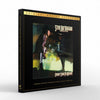























Stevie Ray Vaughan - Couldn't Stand The Weather (2LP, 45 tours, coffret, 1STEP)
ORDER LIMITED TO ONE ITEM PER CUSTOMER
Stevie Ray Vaughan - vocals, guitar [click here to see more vinyl featuring Stevie Ray Vaughan]
Jimmie Vaughan – rhythm guitar on "Couldn't Stand the Weather" and "The Things That I Used to Do"
Tommy Shannon – bass
Chris “Whipper” Layton – drums
Chris Layton – drums
Fran Christina – drums on "Stang's Swang"
Stan Harrison – tenor saxophone on "Stang's Swang"
2LPs, Box
Numbered edition limited to 7,000 copies
Original analog Master tape : YES
UD1S (UltraDisc One-Step)
Heavy Press : 180g SuperVinyl
Record color : black
Speed : 45 RPM
Size : 12'’
Stereo
Studio
Record Press : Record Technology Incorporated
Label : Mobile Fidelity
Original Label : Epic
Recorded January 1984 at Power Station Studio, New York City by Richard Mullen & Rob “Ace” Eaton
Produced by Chris Layton, Jim Capfer, Richard Mullen, Stevie Ray Vaughan, Tommy Shannon
Remastered by Krieg Wunderlich assisted by Rob LoVerde at Mobile Fidelity Soound Lab
Originally released in February 1984
Reissued in January 2021
Tracks:
Side A:
- Scuttle Buttin'
- Couldn't Stand The Weather
- The Things (That) I Used to do
Side B:
- Voodoo Chile (Slight Return)
Side C:
- Cold Shot
- Tin Pan Alley
Side D:
- Honey Bee
- Stand's Swang
Reviews:
“Stevie Ray Vaughan's second album, Couldn't Stand the Weather, pretty much did everything a second album should do: it confirmed that the acclaimed debut was no fluke, while matching, if not bettering, the sales of its predecessor, thereby cementing Vaughan's status as a giant of modern blues. So why does it feel like a letdown? Perhaps because it simply offers more of the same, all the while relying heavily on covers. Of the eight songs, half are covers, while two of his four originals are instrumentals -- not necessarily a bad thing, but it gives the impression that Vaughan threw the album together in a rush, even if he didn't. Nevertheless, Couldn't Stand the Weather feels a bit like a holding pattern, since there's no elaboration on Double Trouble's core sound and no great strides forward, whether it's in Vaughan's songwriting or musicianship. Still, as holding patterns go, it's a pretty enjoyable one, since Vaughan and Double Trouble play spiritedly throughout the record. With its swaggering, stuttering riff, the title track ranks as one of Vaughan's classics, and thanks to a nuanced vocal, he makes W.C. Clark's "Cold Shot" his own. The instrumentals -- the breakneck Lonnie Mack-styled "Scuttle Buttin'" and "Stang's Swang," another effective demonstration of Vaughan's jazz inclinations -- work well, even if the original shuffle "Honey Bee" fails to make much of an impression and the cover of "Voodoo Chile (Slight Return)" is too reminiscent of Jimi Hendrix's original. So, there aren't many weaknesses on the record, aside from the suspicion that Vaughan didn't really push himself as hard as he could have, and the feeling that if he had, he would have come up with something a bit stronger.” AllMusic Review by Stephen Thomas Erlewine
UltraDisc One-Step : Instead of utilizing the industry-standard three-step lacquer process, Mobile Fidelity Sound Lab's new UltraDisc One-Step (UD1S) uses only one step, bypassing two processes of generational loss. While three-step processing is designed for optimum yield and efficiency, UD1S is created for the ultimate in sound quality. Just as Mobile Fidelity pioneered the UHQR (Ultra High-Quality Record) with JVC in the 1980s, UD1S again represents another state-of-the-art advance in the record-manufacturing process. MFSL engineers begin with the original master tapes and meticulously cut a set of lacquers. These lacquers are used to create a very fragile, pristine UD1S stamper called a "convert." Delicate "converts" are then formed into the actual record stampers, producing a final product that literally and figuratively brings you closer to the music. By skipping the additional steps of pulling another positive and an additional negative, as done in the three-step process used in standard pressings, UD1S produces a final LP with the lowest noise floor possible today. The removal of the additional two steps of generational loss in the plating process reveals tremendous amounts of extra musical detail and dynamics, which are otherwise lost due to the standard copying process. The exclusive nature of these very limited pressings guarantees that every UD1S pressing serves as an immaculate replica of the lacquer sourced directly from the original master tape. Every conceivable aspect of vinyl production is optimized to produce the most perfect record album available today.
Ratings :
AllMusic : 4 / 5 ; Discogs : 4.92 / 5




